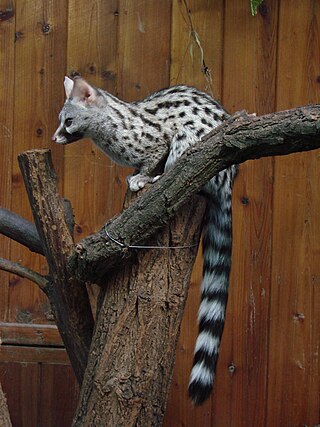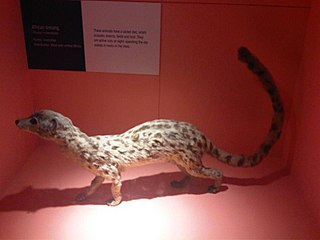
Viverridae is a family of small to medium-sized, feliform mammals. The viverrids comprise 33 species placed in 14 genera. This family was named and first described by John Edward Gray in 1821. Viverrids occur all over Africa, southern Europe, and South and Southeast Asia, across the Wallace Line.

A genet is a member of the genus Genetta, which consists of 17 species of small African carnivorans. The common genet is the only genet present in Europe and occurs in the Iberian Peninsula, Italy and France.

The crested servaline genet, also known as the crested genet, is a genet species endemic to Nigeria and Cameroon. As the population has declined due to loss of habitat, it is listed as Vulnerable on the IUCN Red List. It was first recorded in the Mamfe Division in Cameroon and initially considered a subspecies of the servaline genet. But now it is regarded as a distinct species.

The servaline genet is a genet species native to Central Africa. As it is widely distributed and considered common, it is listed as Least Concern on the IUCN Red List.

The Abyssinian genet, also known as the Ethiopian genet, is a genet species native to Ethiopia, Eritrea, Somalia, Sudan, and Djibouti. It is listed as Data Deficient on the IUCN Red List. It is one of the least-known genet species.

The Angolan genet or miombo genet is a genet species endemic to Southern Africa. It is considered common in this region and therefore listed as Least Concern in the IUCN Red List. Little is known about its ecology.

The common genet is a small viverrid indigenous to Africa that was introduced to southwestern Europe. It is widely distributed north of the Sahara, in savanna zones south of the Sahara to southern Africa and along the coast of Arabia, Yemen and Oman. It is listed as Least Concern on the IUCN Red List.

The rusty-spotted genet, also called panther genet and large-spotted genet, is a genet that is widely distributed in sub-Saharan Africa. It is considered common and therefore listed as Least Concern on the IUCN Red List.

Johnston's genet is a genet species native to the Upper Guinean forests. As it is threatened by deforestation and conversion of rainforest to agriculturally and industrially used land, it is listed as Near Threatened on the IUCN Red List.

The giant forest genet, also known as the giant genet, is a genet species endemic to the Congo Basin. As it is considered as widely distributed and common, it is listed as Least Concern on the IUCN Red List.

The Liberian mongoose is a mongoose species native to Liberia and Ivory Coast. It is the only member of the genus Liberiictis. Phylogenetic analysis shows it is closely related to other small, social mongooses and that the banded mongoose is its closest relative.

The Cape genet, also known as the South African large-spotted genet, is a genet species endemic to South Africa. As it is common and not threatened, it is listed as Least Concern on the IUCN Red List. Like other genets, it is nocturnal and arboreal, preferring to live in the riparian zones of forests, as long as these are not marshy areas.

The Hausa genet is a genet species native to West African savannas. It is listed as Least Concern on the IUCN Red List.

The Central African oyan, also called Central African linsang, is a linsang species native to Central Africa.

Herpestes is a genus within the mongoose family Herpestidae. Several species in the family are known as slender mongooses. It is the type genus of the family, and comprises 5-6 living species, each with several subspecies. Fossil remains of three prehistoric species were excavated in France, and described in 1853.

The Viverrinae represent the largest subfamily of the Viverridae comprising three genera, which are subdivided into six species native to Africa and Southeast Asia. This subfamily was denominated and first described by John Edward Gray in 1864.
The Letaba genet is a genet native to Lesotho, Mozambique, Namibia, South Africa and Eswatini. It is Lesotho and Eswatini's only endemic species of genet.

Genettinae is a subfamily of the feliform viverrids. It contains all of the genet species and the oyan species.

The South African small-spotted genet is a species of genet endemic to Southern Africa.


















